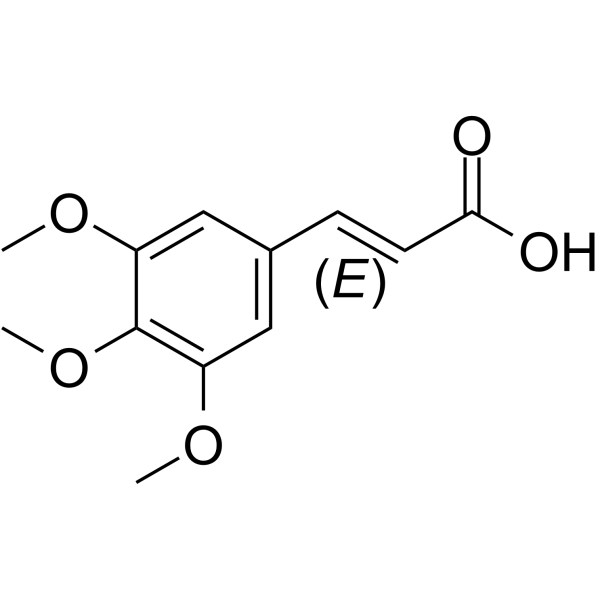Home
Products
3,4,5-Trimethoxy-trans-cinnamic acid



| Product Name | 3,4,5-Trimethoxy-trans-cinnamic acid |
| Price: | Inquiry |
| Catalog No.: | CN06904 |
| CAS No.: | 20329-98-0 |
| Molecular Formula: | C12H14O5 |
| Molecular Weight: | 238.2 g/mol |
| Purity: | >=98% |
| Type of Compound: | Phenylpropanoids |
| Physical Desc.: | Powder |
| Source: | The roots of Notopterygium incisum |
| Solvent: | Chloroform, Dichloromethane, Ethyl Acetate, DMSO, Acetone, etc. |
| SMILES: | COc1cc(/C=C/C(=O)O)cc(c1OC)OC |
| Contact us | |
|---|---|
| First Name: | |
| Last Name: | |
| E-mail: | |
| Question: | |
| Description | (E)-3,4,5-Trimethoxycinnamic acid (TMCA) is a cinnamic acid substituted by multi-methoxy groups. (E)-3,4,5-Trimethoxycinnamic acid is an orally active and potent GABAA/BZ receptor agonist. (E)-3,4,5-Trimethoxycinnamic exhibits favourable binding affinity to 5-HT2C and 5-HT1A receptor, with IC50 values of 2.5 and 7.6 μM, respectively. (E)-3,4,5-Trimethoxycinnamic acid shows anticonvulsant and sedative activity. (E)-3,4,5-Trimethoxycinnamic acid can be used for the research of insomnia, headache and epilepsy[1][2][3]. |
| In Vitro | (E)-3,4,5-Trimethoxycinnamic acid (10 μg/mL, 1 h) increases the expressions of GAD65 and γ-subunit of GABAA receptors in the cerebellar granule cells[3]. (E)-3,4,5-Trimethoxycinnamic acid (0-10 μg/mL, 1 h) shows a significant increase in Cl- influx[3]. Western Blot Analysis[3] Cell Line: Primary cultured cerebellar granule cells Concentration: 10 μg/mL Incubation Time: 1 h Result: Increased expression of GAD65 (glutamic acid decarboxylase) and γ-subunit of GABAA receptors, but did not influence the amounts of a-, b-subunits in the GABAA receptors. Cell Viability Assay[3] Cell Line: Primary cultured cerebellar granule cells Concentration: 1, 3, 5, 10 μg/mL Incubation Time: 1 h Result: Produced a significant increase in Cl- influx. |
| In Vivo | (E)-3,4,5-Trimethoxycinnamic acid (0-20 mg/kg, IP, once) shows anti-seizure effects[2]. (E)-3,4,5-Trimethoxycinnamic acid (0-10 mg/kg, Orally, once) enhances hypnotic effects in pentobarbital-treated mice[3]. Animal Model: Ault male KunMing-strain mice (18-20 g, maximal electroshock (MES) and pentylenetetrazol (PTZ) models)[2] Dosage: 5, 10 and 20 mg/kg; 10 mL/kg Administration: IP, once Result: Significantly decreased the incidence of MES-induced THE (tonic hindlimb extension) to 50% and 20% of the value of the vehicle controls at 10 and 20 mg/kg. Decreased the incidence of MES-induced THE to only 80% at 5 mg/kg. Significantly delayed the onset of myoclonic jerks (MJ), and decreased the seizure severity and mortality compared with the vehicle-treated animals in PTZ seizure model. The incidence of generalized clonic convulsions (stage 4) disappeared at doses of both 10 and 20 mg/kg. Animal Model: ICR male mice (25-28 g, 10-12 in each group)[3] Dosage: 2, 5 and 10 mg/kg Administration: Orally (p.o.), once, 15 min and 1 h prior to pentobarbital injection Result: Significantly decreased locomotor activity at 10 mg/kg. Increased NREM and total sleep, but decreased wakefulness. |
| Density | 1.2±0.1 g/cm3 |
| Boiling Point | 396.4±37.0 °C at 760 mmHg |
| Flash Point | 151.5±20.0 °C |
| Exact Mass | 238.084122 |
| PSA | 64.99000 |
| LogP | 2.00 |
| Vapour Pressure | 0.0±1.0 mmHg at 25°C |